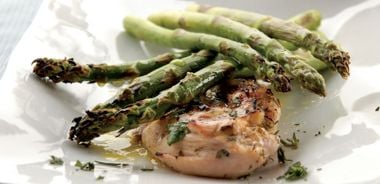Grilled Herb Chicken

14 oz (400 g) boneless, skinless chicken breasts or thighs
1 Tbsp (15 mL) extra-virgin olive oil
1/3 cup (75 mL) fresh lemon juice
2 cloves garlic, minced
1/4 cup (60 mL) combination of diced fresh basil, oregano, and rosemary
Place olive oil, lemon juice, garlic, and fresh diced herbs in a resealable plastic bag or in an 8 x 8 in (2 L) nonmetallic baking dish. Add chicken, ensuring that the marinade coats the chicken. If using a bag, reseal; if using the baking dish, cover. Store in fridge for at least 1 hour or up to 12 hours.
When ready to cook, preheat outdoor barbecue.
Remove chicken from fridge and let sit for 5 minutes. Remove chicken from marinade and place on hot grill. Discard marinade.
Cook chicken on medium direct heat, flipping often to reduce burning and until internal temperature reaches 165 F (74 C), approximately 6 to 15 minutes, depending on the thickness of the chicken.
Remove from grill and place on clean plate. Let sit covered for 5 minutes. Divide chicken evenly among 4 servings.
Serves 4.
Each serving contains:
150 calories; 28 g protein; 2.6 g fat (0.5 g sat fat, 0 g trans fat); 0 g carbs; 0 g fibre; 65 mg sodium
source: "BBQ 101", alive #308, June 2008




